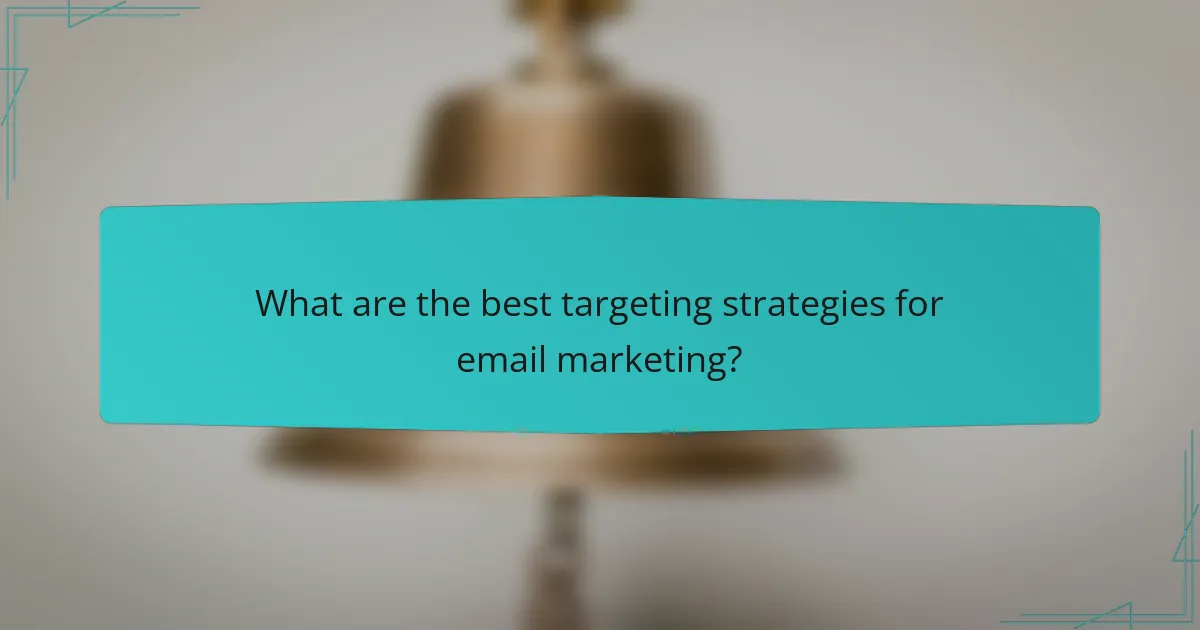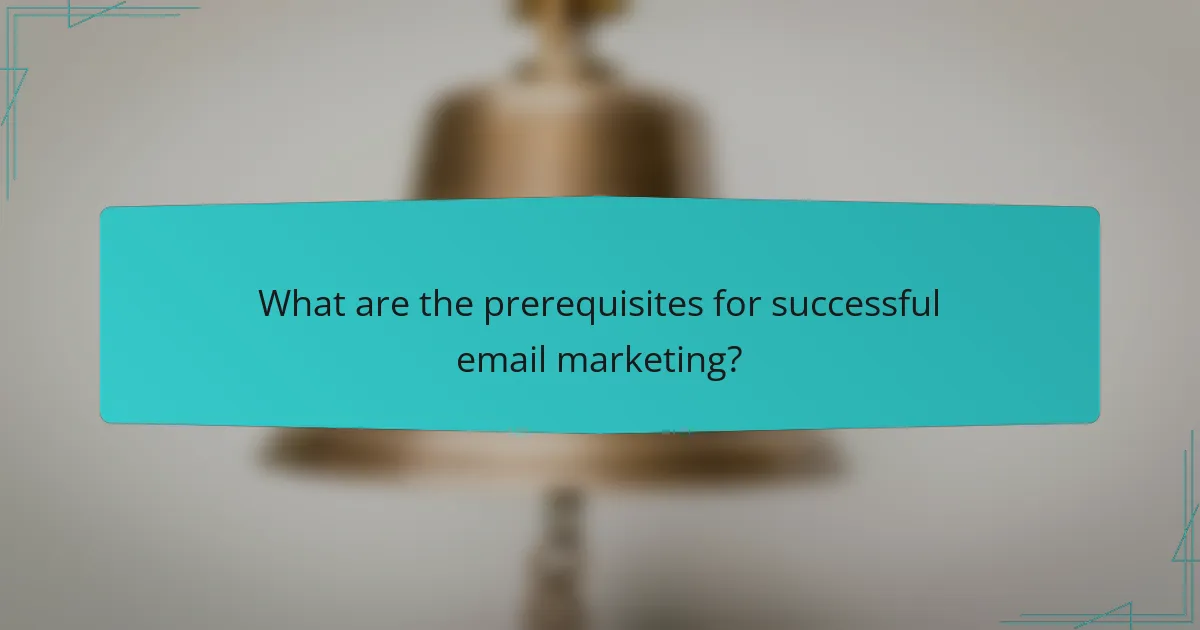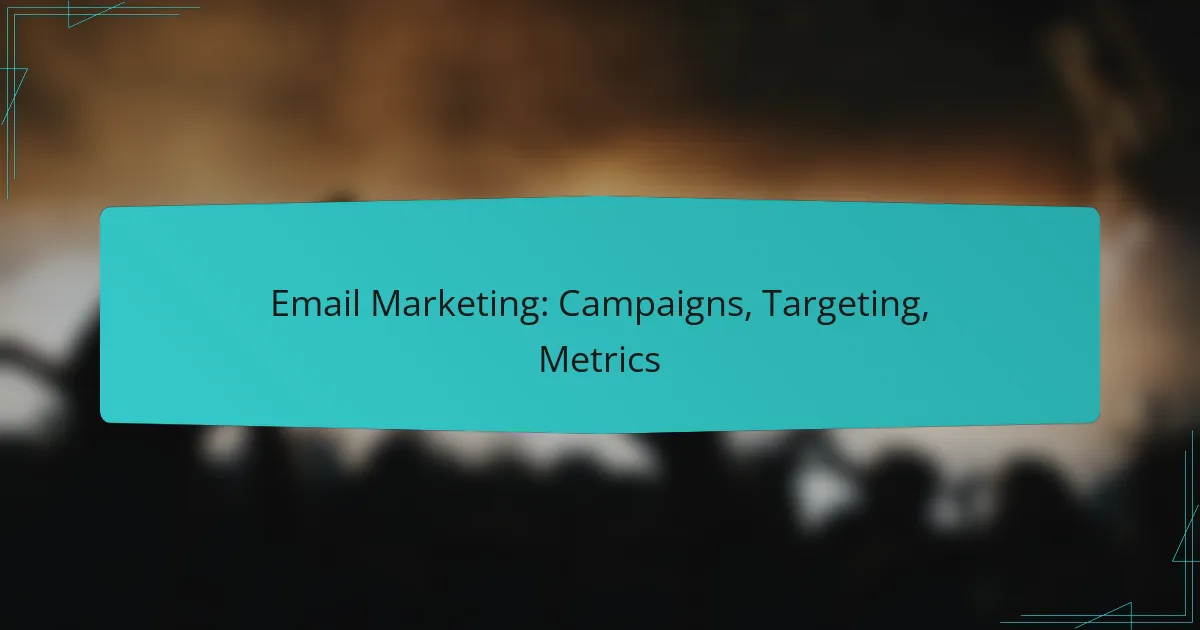Email marketing is a powerful tool for businesses aiming to connect with their audience effectively. By creating targeted campaigns that resonate with specific segments, marketers can enhance engagement and drive conversions. Additionally, tracking key metrics such as open rates and click-through rates is crucial for optimizing future efforts and ensuring ongoing success.

How to create effective email marketing campaigns?
Creating effective email marketing campaigns involves setting clear objectives, understanding your audience, crafting compelling content, leveraging automation, and continuously optimizing your efforts. These steps ensure that your campaigns resonate with recipients and drive desired actions.
Define campaign goals
Start by identifying what you want to achieve with your email marketing campaign. Common goals include increasing sales, boosting website traffic, or enhancing brand awareness. Clearly defined goals help shape your messaging and measure success.
Consider using the SMART criteria—Specific, Measurable, Achievable, Relevant, Time-bound—to refine your objectives. For example, aiming to increase sales by 15% over the next quarter provides a clear target to work towards.
Select target audience
Choosing the right audience is crucial for the effectiveness of your email campaigns. Analyze your existing customer data to segment your audience based on demographics, interests, or past behaviors. This targeted approach increases engagement and conversion rates.
Utilize tools like customer relationship management (CRM) systems to gather insights. For instance, if you are promoting a new product line, focus on customers who have shown interest in similar items in the past.
Design engaging content
Engaging content is key to capturing your audience’s attention. Use a compelling subject line to entice recipients to open your email, and ensure the body content is clear and relevant. Incorporate visuals, such as images or videos, to enhance the message.
Keep your content concise and actionable, including clear calls to action (CTAs) that guide readers on what to do next. For example, phrases like “Shop Now” or “Learn More” can effectively drive user engagement.
Utilize automation tools
Automation tools streamline your email marketing efforts, allowing you to send timely messages without manual intervention. Use platforms like Mailchimp or HubSpot to schedule emails, segment lists, and personalize content based on user behavior.
Consider setting up automated workflows for welcome emails, cart abandonment reminders, or re-engagement campaigns. This ensures that your audience receives relevant messages at the right time, improving overall effectiveness.
Test and optimize
Regular testing and optimization are essential for improving your email marketing campaigns. Conduct A/B tests on subject lines, content layouts, and CTAs to determine what resonates best with your audience. Analyze open rates, click-through rates, and conversion metrics to gauge performance.
Based on test results, make data-driven adjustments to enhance future campaigns. For example, if a particular subject line yields higher open rates, consider using similar phrasing in subsequent emails to maintain engagement.

What are the best targeting strategies for email marketing?
The best targeting strategies for email marketing involve segmenting your audience based on various criteria to enhance engagement and conversion rates. Effective targeting ensures that your messages resonate with specific groups, leading to higher open and click-through rates.
Segment by demographics
Demographic segmentation involves categorizing your email list based on characteristics such as age, gender, income, and education level. This approach allows you to tailor your content to meet the specific needs and preferences of different demographic groups.
For instance, a fashion retailer might send different promotions to young adults versus older customers, ensuring that the messaging aligns with their interests. Consider using surveys or registration data to gather this information effectively.
Behavioral targeting
Behavioral targeting focuses on the actions and interactions of users with your brand, such as past purchases, website visits, and email engagement. By analyzing this behavior, you can create highly relevant email campaigns that speak directly to the interests of your audience.
For example, if a customer frequently browses a particular product category, sending them targeted offers or recommendations can significantly increase the likelihood of conversion. Utilize tracking tools to gather insights on user behavior for optimal targeting.
Personalization techniques
Personalization techniques involve customizing email content to reflect individual preferences and behaviors. This can include using the recipient’s name, recommending products based on past purchases, or tailoring content based on previous interactions.
Effective personalization can lead to higher engagement rates. For example, emails that include personalized subject lines have been shown to improve open rates significantly. Use data analytics to refine your personalization strategies continuously.
Geographic segmentation
Geographic segmentation divides your audience based on their location, allowing you to send location-specific content and offers. This strategy is particularly useful for businesses with physical stores or region-based services.
For instance, a restaurant chain might promote different menu items based on local tastes or seasonal availability. Ensure that your email campaigns account for time zones and local events to maximize relevance and engagement.

What metrics should be tracked in email marketing?
Tracking key metrics in email marketing is essential for evaluating campaign performance and optimizing future efforts. The primary metrics to focus on include open rates, click-through rates, conversion rates, and unsubscribe rates, each providing insights into different aspects of audience engagement.
Open rates
Open rates measure the percentage of recipients who open your email compared to the total number of emails delivered. A typical open rate can range from 15% to 25%, depending on the industry and audience. High open rates indicate effective subject lines and sender recognition.
To improve open rates, consider segmenting your audience and personalizing subject lines. Avoid spammy language and ensure your emails are optimized for mobile devices, as many users check emails on their phones.
Click-through rates
Click-through rates (CTR) represent the percentage of recipients who click on one or more links within your email. A good CTR typically falls between 2% and 5%, varying by industry and email type. This metric helps assess the effectiveness of your email content and call-to-action.
To boost CTR, use clear and compelling calls-to-action, and ensure that your links are easily identifiable. A/B testing different content formats can also help identify what resonates best with your audience.
Conversion rates
Conversion rates indicate the percentage of recipients who complete a desired action after clicking through your email, such as making a purchase or signing up for a webinar. Conversion rates can vary widely, often ranging from 1% to 5%, depending on the offer and audience targeting.
To enhance conversion rates, ensure that the landing page aligns with the email content and provides a seamless user experience. Highlight benefits clearly and minimize distractions on the landing page to guide users toward the desired action.
Unsubscribe rates
Unsubscribe rates show the percentage of recipients who opt out of your email list after receiving a campaign. A healthy unsubscribe rate is generally below 1%. High rates may indicate that your content is not meeting audience expectations or that you are emailing too frequently.
To reduce unsubscribe rates, focus on delivering valuable content that aligns with subscriber interests. Regularly clean your email list to remove inactive subscribers and consider offering preferences for email frequency and content types to better meet user needs.

What are the prerequisites for successful email marketing?
Successful email marketing requires a well-defined strategy, a quality email list, and adherence to relevant regulations. These elements ensure that campaigns reach the right audience effectively while maintaining compliance with legal standards.
Build a quality email list
Creating a quality email list is essential for effective email marketing. Focus on gathering subscribers who are genuinely interested in your content, products, or services. This can be achieved through sign-up forms on your website, social media promotions, or lead magnets like free resources.
Regularly clean your email list by removing inactive subscribers to maintain engagement rates. Aim for a list that reflects a specific target audience, as this will enhance the relevance of your campaigns and improve overall performance.
Ensure compliance with regulations
Compliance with email marketing regulations, such as the General Data Protection Regulation (GDPR) in Europe and the CAN-SPAM Act in the United States, is crucial. These laws dictate how you can collect, store, and use email addresses, emphasizing the need for transparency and consent.
To ensure compliance, always obtain explicit permission from subscribers before sending marketing emails. Include clear opt-out options in every email, and honor unsubscribe requests promptly. Familiarizing yourself with local regulations can help you avoid legal issues and build trust with your audience.

How to choose the right email marketing platform?
Choosing the right email marketing platform involves assessing your specific needs, budget, and the features offered by various providers. Look for a platform that aligns with your goals, whether it’s automation, analytics, or integration with other tools.
Evaluate features and integrations
When evaluating email marketing platforms, consider the essential features such as automation capabilities, segmentation options, and reporting tools. Look for integrations with your existing software, like CRM systems or e-commerce platforms, to streamline your marketing efforts.
Common features to assess include drag-and-drop email builders, customizable templates, and A/B testing functionalities. Ensure that the platform supports integrations with popular tools like Salesforce, Shopify, or Google Analytics to enhance your marketing strategy.
Additionally, check for compliance with regulations such as GDPR or CAN-SPAM, which can impact your email campaigns. A platform that offers built-in compliance features can save you time and reduce legal risks.



